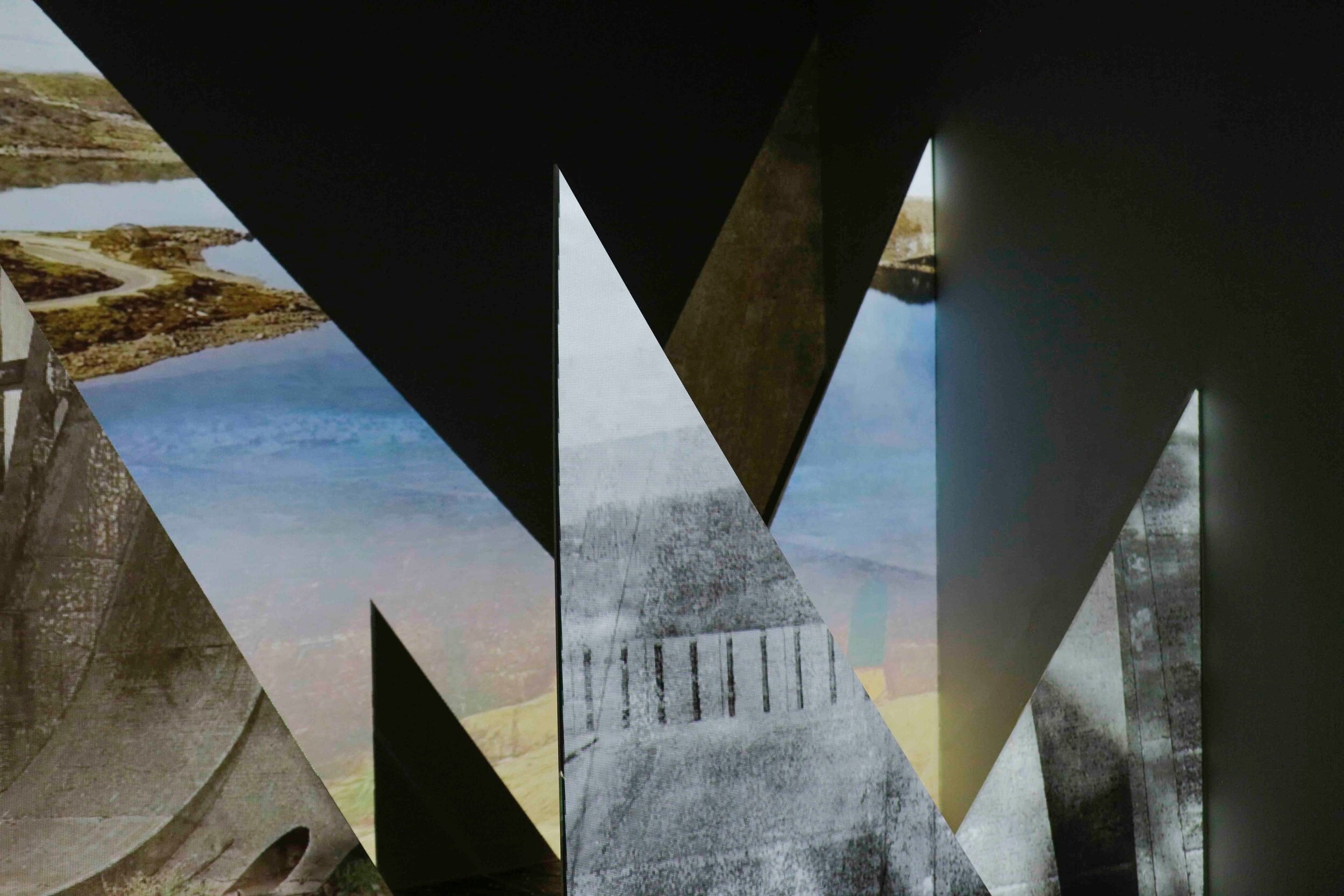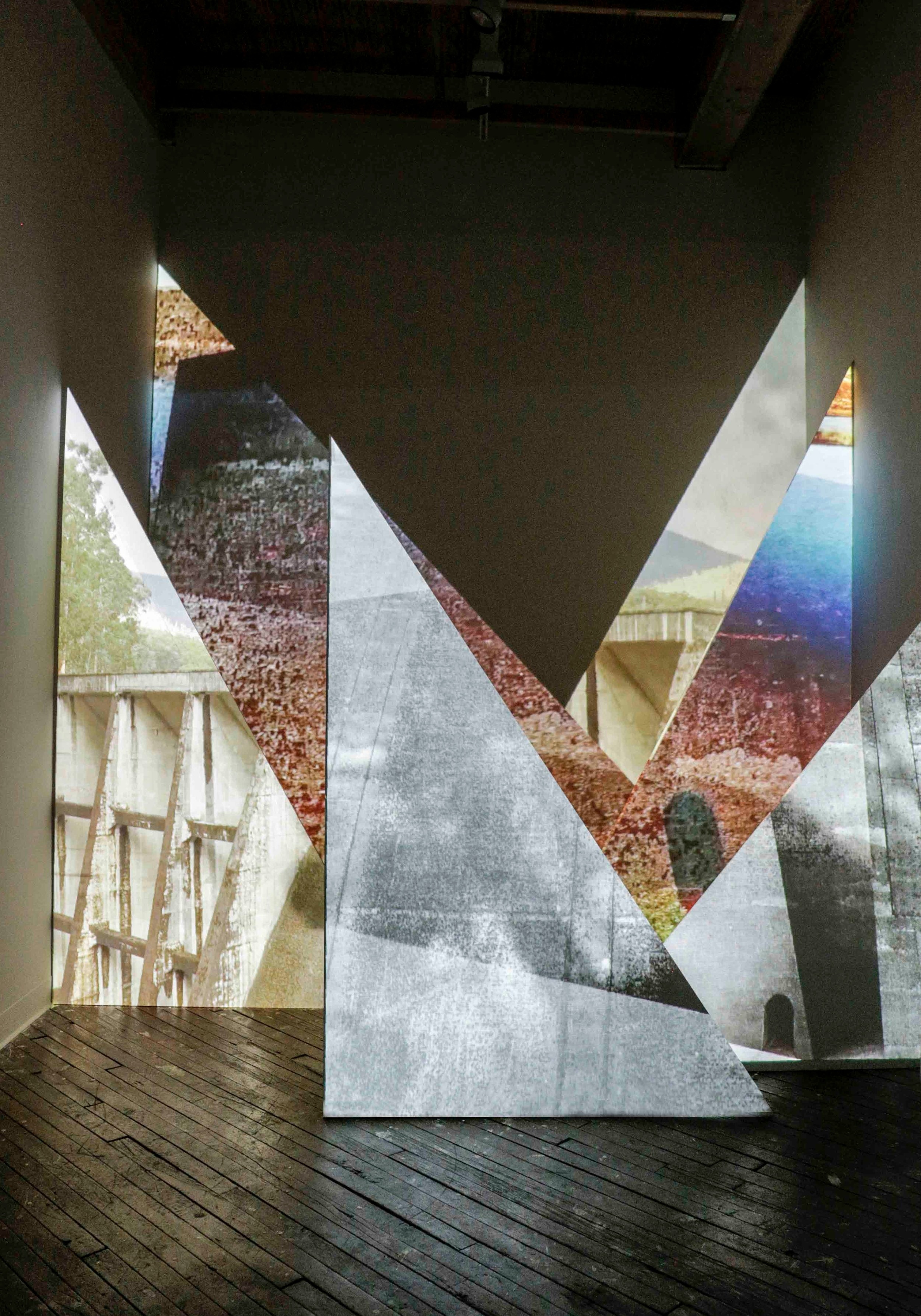A Guided Walk Through the Contemporary Sublime: Shannon Lean Collis’ Kiewa
A Guided Walk Through the Contemporary Sublime
SHANNON LEAH COLLIS’ KIEWA
Deborah Barkun’s essay, A Guided Walk Through the Contemporary Sublime: Shannon Lean Collis’ Kiewa, is the fifth in a series of essays archiving one year of Grizzly Grizzly exhibitions, in celebration of our 10th year as an artist collective. Throughout the year, we will be collaborating with exhibiting artists and emerging and established writers to produce essays that critically reflect on the exhibitions and expand the ideas explored in our experimental project space. In addition to being posted on this blog, the collected essays will culminate in our first bound publication, to be released in September 2019. Support for this year-long project, that fosters writing in the visual arts, was generously provided by The Velocity Fund administered by Temple Contemporary with generous funding from The Andy Warhol Foundation for the Visual Arts. Kiewa was made possible by the Bogong Centre for Sound Culture's residency program and the Canada Council for the Arts. Nous remercions le Conseil des arts du Canada de son soutien.
At the far end of Grizzly Grizzly, the six pristine right triangles of Shannon Leah Collis’ multimedia installation Kiewa rise in darkness like a minimalist mountain range. These peaks occupy space sculpturally, stretching laterally across the far quarter of the gallery, with a single, freestanding peak emerging in the foreground. Geometric purity is where associations with minimalism end, however. The triangular forms screen dynamic and spectacular video collages depicting Australia’s Alpine National Park and the neighboring Kiewa hydroelectric complex. In an exemplary segment, two screens feature horizontal pans of tranquil Lake Guy reflecting the jagged glacial rocks of Mt. Beauty to a specular finish, intermittently veiled by images of the rushing Kiewa River. Simultaneously, against the lateral motion of passing landscape, scrolling images of the lithic monumentality of Kiewa Dam and the elegant latticework of its attendant hydroelectric towers alternately ascend or descend the four remaining screens in architectonic majesty. In situ and installed, naturally formed mountains meet fabricated mountains, and currents are harnessed and tamed. Each screen presents a fragmented view of the Kiewa environs, unified by a palette that fluctuates in intensity and a deeply resonant hum that builds in momentum. Kiewa’s visual fragmentation and directional shifts destabilize the viewer’s senses of scale and perspective. Immersed in Kiewa, the modest space of Grizzly Grizzly feels dizzyingly limitless. The erratic immensity of landscape is, at once, rendered in and expansive of human scale, evoking a particularly contemporary experience of the sublime—a curious aesthetic experience of simultaneous awe and terror—in which the natural environment and humanity’s imprints upon it are co-implicated. Kiewa’s sensorial abundance reveals the degree to which our hybrid landscape remains ultimately unknowable and unfathomable.
Shannon Leah Collis, Keiwa, Two-channel video installation, audio, dimensions variable, 2019
In 2018, Collis spent two weeks in residence at the Bogong Centre for Sound Culture, where she encountered the Victorian Alpine region through daily walks that emphasized both active and passive listening and looking, initially unmediated by recording or documenting devices. The process of intensive, embodied absorption heightened Collis’ engagement with this unfamiliar terrain. Her explorations were guided, in part, by composer and musician Pauline Oliveros’ philosophies of Deep Listening, in particular the directive, “Listen to everything all the time and remind yourself when you are not listening.”[1] As in Oliveros’ work more generally, ambient sound, including one’s “internal and external sounds,” comprise music of daily life: “You are part of the environment,” she writes.[2] Here, the act of deep listening sensitizes the subject’s aural acuity while subsuming her to the sonic environment. Electronic journal entries reveal Collis’ developing bond with the Bogong region and connections between embodied experience and processes of documentation or representation. After days of unmediated communing with the environment, Collis transitions from “visitor” to “part of the place,” enabled by her assumption of camera and sound recorder.[3] Now part of the environment, the artist walks the hybrid landscape in a “state of perceptual receptivity,” sourcing images and sound: the raw materials for Kiewa.
For the realization of Kiewa, Collis performs the role of artist-cartographer. Her methodology engages various mapping strategies to absorb the landscape’s character. Walking the Kiewa landscape constitutes a corporeal cartography of the terrain through physical sensation: the coarse crush of stone underfoot, the length of a stride, herbaceous notes of grasses, spray from falling water, an awkward torsion to evade a thorny limb, the diminution of embodied physicality in proximity of mountains, both natural and constructed. This somatic mapping informs the mapping she undertakes in-camera and through audio field recording, which provide once-mediated data harvested on location. Collis’ processes of editing comprise a third form of mapping: charting a discernable course through an abundance of information. Lastly, the artist integrates, collages, and digitally maps this material onto triangular screens installed in the gallery. In quest of representation that effectively captures an experience of place, Collis invokes multiple technologies of mapping, each constituting a distinct way of acquainting with surroundings. And yet, the sum of these domains of visual, aural, perceptual, and technological knowledge is a work that, despite its multisensory immersive generosity, eludes the possibility of ever grasping the forces that inspire it. Kiewa bathes viewers in rich, fragmented topography, making iterable the chaos and volatility of nature but also the chaos and volatility of human interventions in it.
Experiencing the spatial, visual, aural, and temporal sensations of Kiewa, one cannot help but consider the precariousness of the natural environment at the hands of its human inhabitants. As global temperatures and sea levels rise, weather patterns shift or become more severe, and resource scarcity leads to adaptation, endangerment, and climate migration. Oceans acidify, lead taints drinking water, and air and land grow toxic, consequential to human productivity. In Edmund Burke’s and Immanuel Kant’s Enlightenment-era conceptions of the sublime, the concomitant sensations of terror and awe, necessarily realized from a position of security, manifested as liberatory; from a safe distance, one can contemplate dynamic natural forces as sheer, aesthetic thrill. However, feminist philosopher Bonnie Mann argues that our contemporary context collapses our ability to stand apart from the natural world. “The fantasy of nature as a human construction is not mere fantasy,” she writes, continuing, “our creations have changed our relationship to the natural world and are changing nature itself, in often terrifying ways.”[4] For Mann, the “natural sublime is a powerful experience that lays bare our relation to the natural world, and it lays bare the deep entanglements of natural and intersubjective dependencies.”[5] In other words, we cannot extricate our relationship to the natural world from our relationship to each other; they are codependent. Under the conditions of contemporary life, Mann’s “natural sublime” is inflected with grief:
We cannot look upon a waterfall or mountain, raging river or vast forest, without the grief associated with the question, what have we done? combining with our terror.[6]
Here, the terror effect of the sublime is greater than aesthetic phenomenon; it is a terror partially of our own making. In Mann’s assessment, our interventions are assaults on the natural world, which responds, in turn, with increasing ferocity, necessarily impacting how one experiences the sublime. Ultimately, Mann’s project is political, championing connections between people and places over individual sovereignty and aesthetic distance and transcending specificity of place to address global community. The natural sublime’s “play of terror and exhilaration moves us...to ask, How might this place be saved?” Mann’s natural sublime thus evokes urgency.
Kiewa’s absorptive, sonorous spectacle—intimate yet vast, natural and built, multidirectional—unmoors the viewer, arousing a technologically mediated sublime that eclipses the gallery context. Kiewa presents a confluence of foliaged Alpine terrain and Brutalist hydroelectric grandeur that comprise a more ecological system of power generation in a region formerly reliant on coal-generated power.[7] Yet, Kiewa’s potency derives from tension, ambivalence, and melancholy that dwell just below the work’s brilliant surface. The human imprint on the earth’s landscape, writ large, lingers as a Barthesian punctum, a detail that “pricks” or moves the viewer. Like a preemptive memorial, Kiewa’s apparent aesthetic and generative harmony compel us to acknowledge a planet unknowable, unfathomable, unbalanced, and in need.
[1] Oliveros, Pauline, quoted in Shannon Leah Collis. “Entry #1: The Poetics of Environmental Sound.” bogongsound.com.au.
http://bogongsound.com.au/artists/shannon-leah-collis/jornal-1 (accessed July 26, 2019).
[2] Oliveros, Pauline, quoted in Shannon Leah Collis. “Entry #1: The Poetics of Environmental Sound.” bogongsound.com.au.
http://bogongsound.com.au/artists/shannon-leah-collis/jornal-1 (accessed July 26, 2019).
[3] Collis, Shannon Leah. “Entry #1: The Poetics of Environmental Sound.” bogongsound.com.au.
http://bogongsound.com.au/artists/shannon-leah-collis/jornal-1 (accessed July 28, 2019).
[4] Bonnie Mann, Women’s Liberation and the Sublime: Feminism, Postmodernism, Environment (Oxford: Oxford University Press, 2006), 160-1.
[5] Mann, 160-1.
[6] Mann, 163.
[7] Victorian Collections, victoriancollections.net.au.
https://victoriancollections.net.au/items/595b6ab5d0cde50bd42215fd (accessed July 26, 2019).
Deborah Barkun holds a BFA in Studio Art from Carnegie-Mellon University and an MA/PhD in History of Art from Bryn Mawr College. Her research on social dynamics of artistic collaboration has been supported by the Henry Luce Foundation, the American Council of Learned Societies, the Whiting Foundation, and a Coleman Dowell Fellowship for Study on Experimental Works. She served as Visiting Scholar in Residence at Lingnan University in Hong Kong, and presently serves as Chair of the Department of Art and Art History and Director of Museum Studies at Ursinus College. Her current project is entitled Tangled Webs: Artist Arachnid Models of Working.
Shannon Leah Collis is an interdisciplinary artist. She is a graduate of the MFA program at the University of Alberta, Edmonton, and has completed post-graduate research at Concordia University in Montreal in the area of Digital Media and Computation Arts. Collis is also a 2015 and 2018 recipient of a Visual Artist Grant from the Canada Council for the Arts. She creates installations and interactive environments that explore various ways in which digital technologies can transform one’s perception of audio and visual stimuli. Her work has been exhibited widely across North America as well as in Europe, Asia, Australia and Brazil. Collis is currently an Associate Professor at the University of Maryland, where she teaches digital media and sound.




